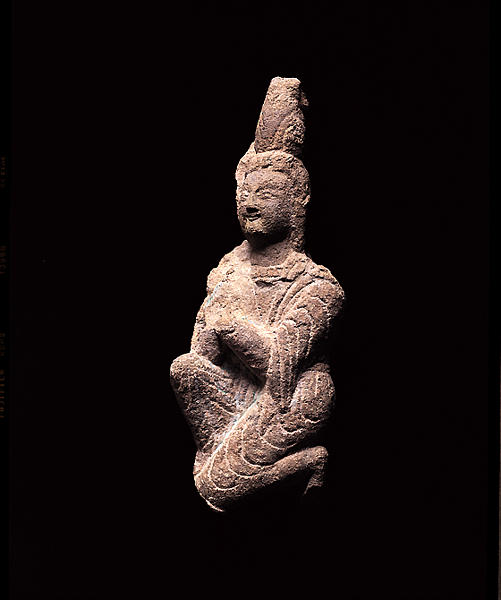供養天像
- 中国
- 中国・北魏時代
- 5世紀後期
- 砂岩
- H-48.2
- 所蔵
- 雲岡石窟 第1窟請来と推定される
雲岡諸窟に残されている供養天の内、本像のような菩薩形の像を整理してみると、供養天の着衣形式には8種類が認められることがわかる。これらを、形式と作風の両面から検討すると、本像の故地が雲岡第1・2窟であった可能性が浮かび上がってくる。そこで、もしも第1・2窟を鉗耳慶時が開削した窟に充てる考えに従うことが許されるならば、本像の製作時期は太和8年(484)から同13(489)の間に限定し得ることになる。
仏教の伝播
仏教の伝播
大乗仏教はシルクロードを経て西域、中国へと伝えられて行きました。このようにインドから北の方面に伝播した仏教を北伝仏教といいますが、この中には南方の海路を通じたり、インドから直接チベットに伝えられた仏教も含まれています。一方、インドより南に伝播した仏教を南伝仏教にお名でよぶことがありますが、内容的には小乗部派仏教の一派で、上座部仏教またはパーリ仏教と呼ばれるものが伝えられており、今日のスリランカ、ビルマ、タイ、カンボジア、ラオスなどで行われています。
ただし、ジャワ、スマトラ方面に伝えられた仏教は、内容的には北伝仏教に属するものです。
仏頭
Catalogue Entry
Carved into the sandstone cliff in the Wuzhou hills west of the city of Datong (ancient Ping Cheng) in Shanxi province is the massive temple complex of Yungang, which includes some two-hundred large and small caves. Construction of the Yungang cave temples started at the beginning of the Heiping era (A.D. 460-466), when the monk Tan Yao followed the behest of Emperor Wen Zheng, and continued until the end of the Northern Wei dynasty. The sculptural expression at the Yungang caves gradually evolved from an Indian-based style to a more sinicized or Chinese style. The clothing on the attendant deities reflects this evolution from an essentially Indian form, with scarves draped across the upper body and the majority of the flesh exposed, to the use of clothing that covers both shoulders and conceals the upper body, and, finally, to a more Chinese-style robe with wide sleeves and a front closure.
Given the use of soft sandstone, the smiling expression, the rounded face, and the overall sensibility, this sculpture reflects a transitional style visible at the Yungang Buddhist caves during the Northern Wei dynasty. The posture of the image--kneeling in adoration--suggests that this figure is one of the "attendant deity" bodhisattva images, a number of which remain in the caves. These attendant bodhisattva images have eight types of drapery patterns. Some have drapery configurations that resemble the Shumei example, specifically a front-opening, wide-sleeved robe with a belt at the hips, which is found in Caves 1, 2, 5, 16, 17, 18, 19, 19B, and 37. An analysis of these extant images and their features that are also visible in the Shumei attendant--the belt at the back of the waist combined with a decreased sense of volume--and also those that retain a sense of the earlier, more Indian sculptural style, strongly suggests that the Shumei bodhisattva came from Yungang Cave 1 or Cave 2, which can be dated to the Taihe era, A.D. 484-489.1
HK
1. The proposed dating of this statue is based on two theories. Su Bai dates Caves 9 and 10 to the Taihe era (A.D. 484-489). The drapery patterns of the attendant deities found in Caves 9 and 10 are almost all restricted to thin scarf forms, and there is absolutely no trace of sinification in their forms (see Su Bai 1978). This author suggests that Caves 1 and 2 can also be dated to the Taihe era, since the sinification policies of Emperor Xiaowen that affected Northern Wei society occurred largely during these years (see Katayama 1997). The present example reflects a transitional sculptural style, with the Indian characteristics dominant earlier combined with some sinicized elements, such as the decreased volume of the figure.
